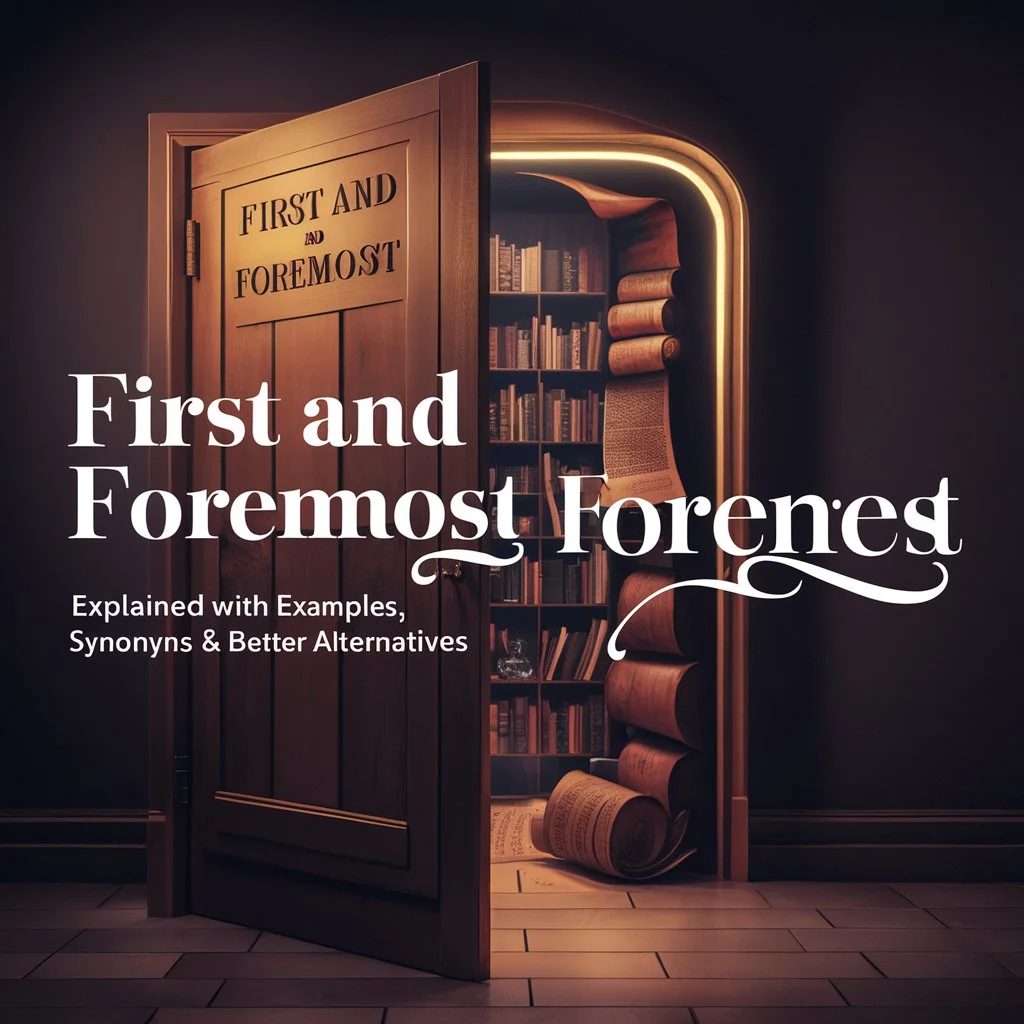Language is full of expressions that people use to organize thoughts, emphasize points, and sound natural in communication. One phrase that often appears in writing, speeches, and even casual texting is “first and foremost.”
But what does “first and foremost” mean, and how else can you say it? This guide explores the meaning, tone, and context of the phrase while offering 16+ polished alternatives you can use. Whether you’re writing an academic essay, sending a professional email, or texting a friend, you’ll find the right substitute here.
We’ll also explore how alternatives to “first and foremost” compare with another modern shorthand expression: “asl meaning in text.” While “asl” (short for age, sex, location) is an informal online abbreviation, “first and foremost” is far more formal and rhetorical. Knowing when and how to switch between these tones is essential for effective communication.
By the end of this article, you’ll not only know the nuances of the phrase but also gain a toolkit of professional, polite, and casual alternatives—with practical texting examples to guide you.
What Does “First and Foremost” Mean?
The phrase “first and foremost” is typically used when you want to highlight the most important point or priority before mentioning anything else.
- First = the beginning, initial priority.
- Foremost = the leading, most significant, or most important.
Together, they reinforce the idea that what follows should be seen as the top priority.
Example:
- “First and foremost, I want to thank everyone who supported me.”
- “First and foremost, safety must be our concern.”
This phrase carries a formal and rhetorical tone. You’ll often see it in speeches, academic writing, business reports, or professional announcements.
Why Look for Alternatives?
While “first and foremost” is widely understood, using it repeatedly can sound repetitive, overly formal, or outdated. In more casual settings, it might even feel too stiff.
- In formal writing, alternatives can provide variety and precision.
- In emails or meetings, simpler expressions might sound more approachable.
- In texts or casual chats, short substitutes can keep the tone light and natural.
16+ Alternatives to “First and Foremost”
Here’s a list of versatile alternatives categorized into formal, professional, and casual options, each with examples and tone notes.
1. Above All
This phrase emphasizes what is most important.
- Tone: Formal or professional.
Example:
- “Above all, we must remain focused on our goals.”
Texting Example:
- “Above all, just take care of yourself right now.”
2. Primarily
A clear, academic alternative that signals the main focus.
- Tone: Formal, academic, professional.
Example:
- “The report primarily discusses the impact of climate change.”
Texting Example:
- “I’m primarily worried about whether you’re okay.”
3. Most Importantly
Simple and direct, great for both speech and text.
- Tone: Neutral, suitable in all settings.
Example:
- “Most importantly, remember to enjoy the process.”
Texting Example:
- “Most importantly, don’t stress too much about it 😌.”
4. Chiefly
Adds an elevated or slightly formal feel.
- Tone: Professional, business, or academic.
Example:
- “The meeting is chiefly about budget planning.”
Texting Example:
- “I’m chiefly excited about our trip!”
5. Before Anything Else
Feels conversational and friendly.
- Tone: Casual and personal.
Example:
- “Before anything else, I want to apologize for the delay.”
Texting Example:
- “Before anything else, HAPPY BIRTHDAY 🎉!”
6. Fundamentally
Highlights a core or essential truth.
- Tone: Formal, professional.
Example:
- “Fundamentally, the project aims to improve customer experience.”
Texting Example:
- “Fundamentally, we’re just two friends figuring life out.”
7. At the Top of the List
Sounds approachable while still emphasizing priority.
- Tone: Professional or casual.
Example:
- “At the top of the list is ensuring team safety.”
Texting Example:
- “At the top of the list: pizza 🍕 tonight?”
8. Most of All
Soft and expressive, suitable for emotions.
- Tone: Warm, friendly, or personal.
Example:
- “Most of all, I appreciate your patience.”
Texting Example:
- “Most of all, I just miss hanging out with you.”
9. In the First Place
Direct and versatile, can work in many settings.
- Tone: Neutral, professional, casual.
Example:
- “We shouldn’t have gone there in the first place.”
Texting Example:
- “Why did you even agree in the first place? 😅”
10. To Begin With
Common in conversations and explanatory writing.
- Tone: Neutral, often casual.
Example:
- “To begin with, let’s address the main issue.”
Texting Example:
- “To begin with, you never told me the full story 👀.”
11. First Off
Short and friendly—perfect for texting or informal chats.
- Tone: Casual.
Example:
- “First off, I want to thank you for being here today.”
Texting Example:
- “First off, that meme you sent cracked me up 😂.”
12. Mainly
A straightforward, business-like choice.
- Tone: Professional.
Example:
- “The project mainly focuses on user engagement.”
Texting Example:
- “I was mainly just tired, not upset.”
13. To Start With
Close to “to begin with,” but a little more relaxed.
- Tone: Casual or conversational.
Example:
- “To start with, let’s cover the basics.”
Texting Example:
- “To start with, when are you free this weekend?”
14. First Priority
Strong, professional, and clear.
- Tone: Formal or professional.
Example:
- “Employee safety is our priority.”
Texting Example:
- “My priority tonight is sleep 😴.”
15. Chief Concern
Useful for serious discussions.
- Tone: Professional, formal.
Example:
- “Our chief concern is meeting the deadline.”
Texting Example:
- “My chief concern rn is whether you’re okay.”
16. Most Crucially
Emphasizes urgency and importance.
- Tone: Formal or professional.
Example:
- “Most crucially, we need to address security risks.”
Texting Example:
- “Most crucially, don’t forget to bring snacks 🥤.”
17. First Thing (Bonus Alternative)
Short, simple, and often used in speech.
- Tone: Casual, conversational.
Example:
- “First thing, let’s go over the schedule.”
Texting Example:
- “First thing tomorrow, coffee ☕?”
Comparing “First and Foremost” with “ASL Meaning in Text”
It’s worth noting the contrast between formal phrases like first and foremost and internet abbreviations like asl.
- “First and foremost” → Emphasizes importance in formal or professional contexts.
- “asl in text” → Internet shorthand (age, sex, location), casual, and used in chat rooms or direct messages.
By recognizing tone differences, you can adjust your word choice depending on whether you’re speaking in a boardroom, writing an academic paper, or sending a text to a friend.
11 Texting Examples Optimized for Google
Here are 11 short, natural, and relatable texting examples that showcase alternatives to “first and foremost.” These are user-friendly and easy to apply:
- “Above all, I just want you to be happy 💙.”
- “Primarily, I’m worried about your safety.”
- “Most importantly, let’s stick together.”
- “Before anything else, good luck today!”
- “First off, thanks for always being there 🙌.”
- “To start with, I’m starving 😂.”
- “My priority is getting enough rest tonight.”
- “Most of all, I’m proud of you.”
- “In the first place, why didn’t you call?”
- “Fundamentally, it’s about trust between us.”
- “First thing in the morning, let’s meet up ☕.”
These examples show how different tones (casual, supportive, professional) can make your messages more authentic and context-appropriate.
How to Choose the Best Alternative
When selecting a substitute for “first and foremost,” consider:
- Formality of the situation: “Above all” or “Most importantly” for speeches; “First off” for texting.
- Clarity: Use short and simple options (“First thing,” “Mainly”) in everyday chats.
- Impact: Choose weightier terms (“Fundamentally,” “Chiefly”) when emphasizing serious matters.
Final Thoughts
The phrase “first and foremost” remains a useful and respected expression, but language thrives on variety and adaptability. Whether you’re drafting a professional report, giving a heartfelt speech, or sending a casual text, you now have a wide range of 16+ alternatives at your disposal.
By blending formal, professional, and casual options, you can communicate with clarity, authenticity, and precision—always adapting to the audience and context.





